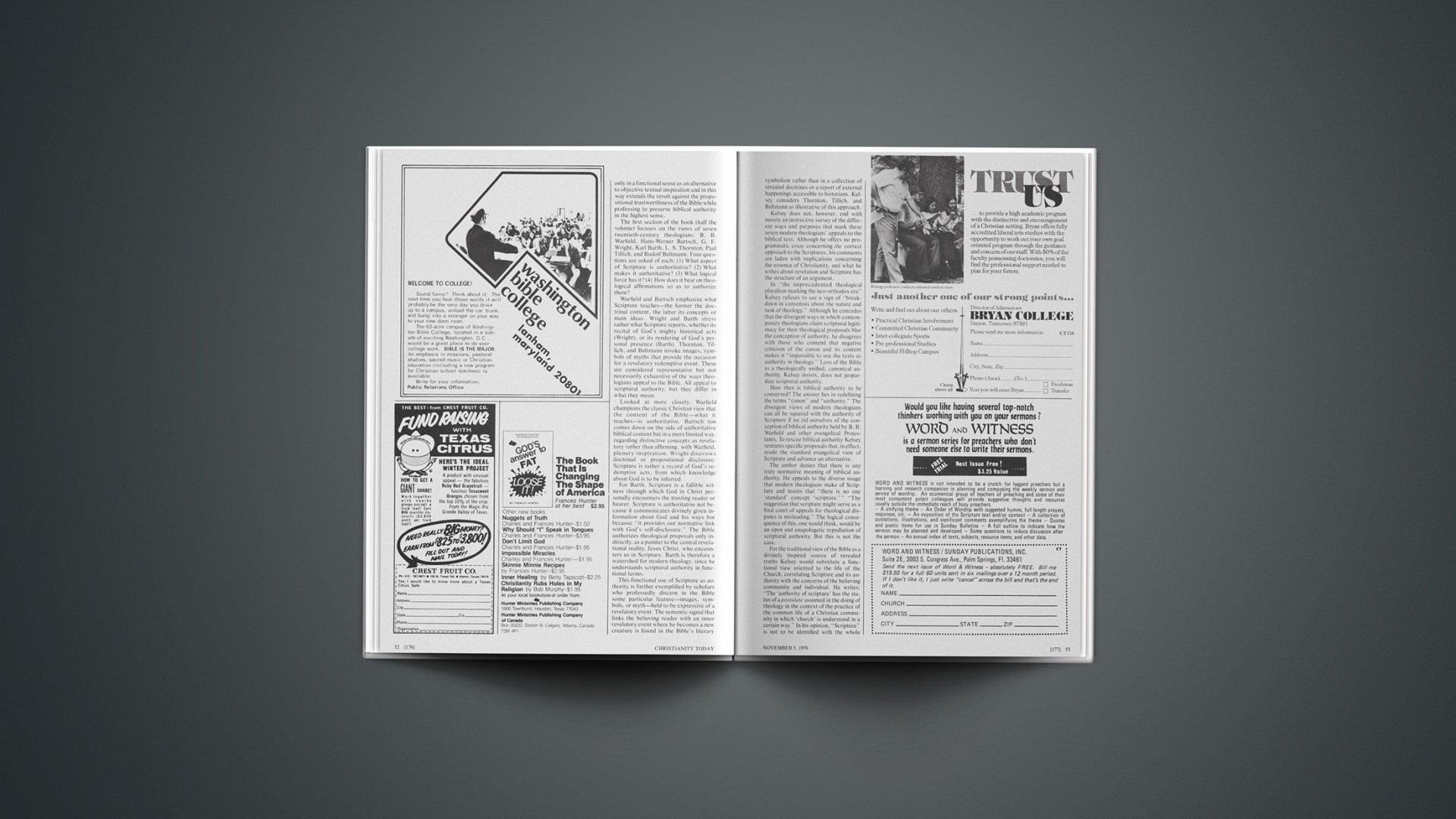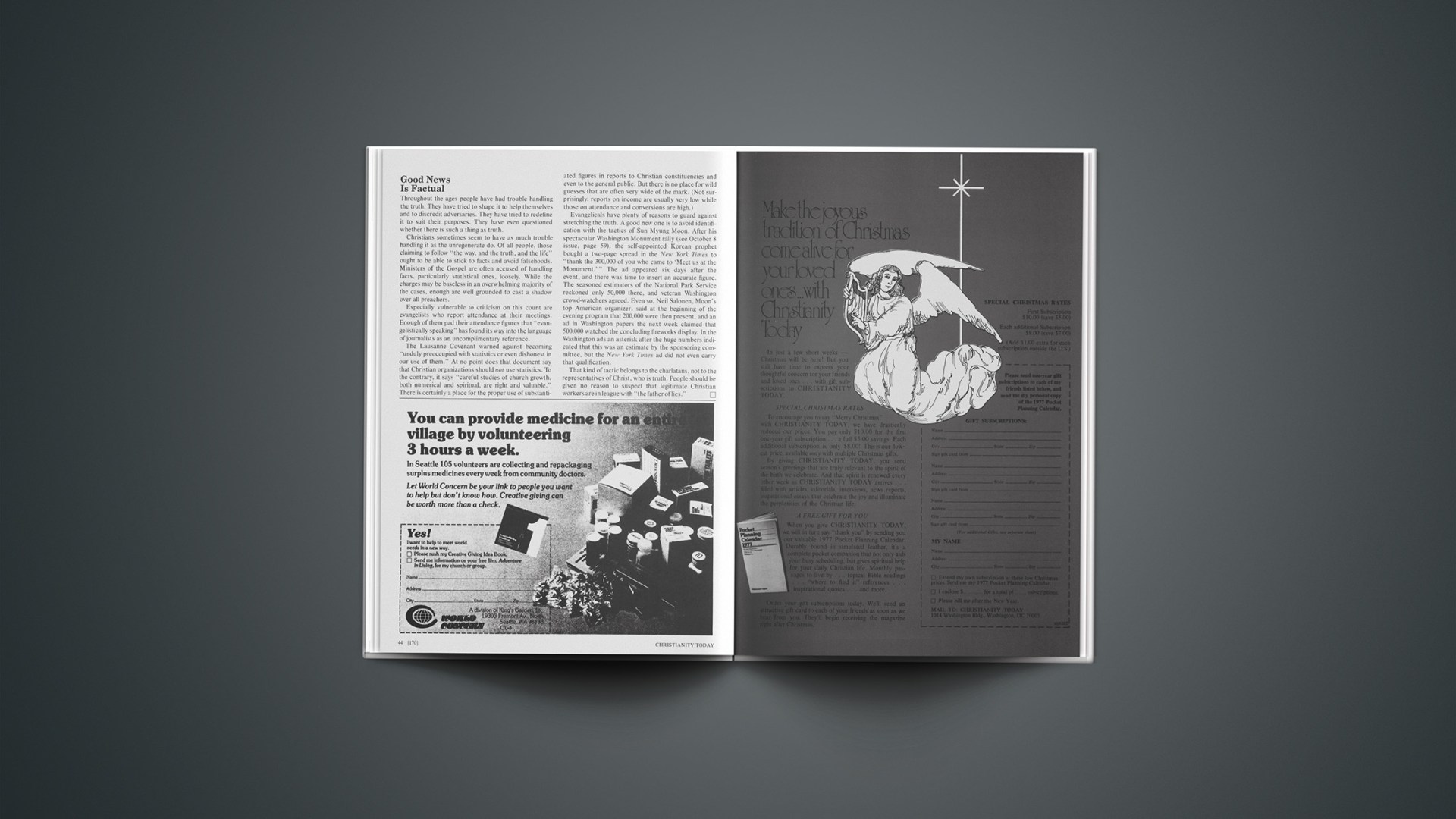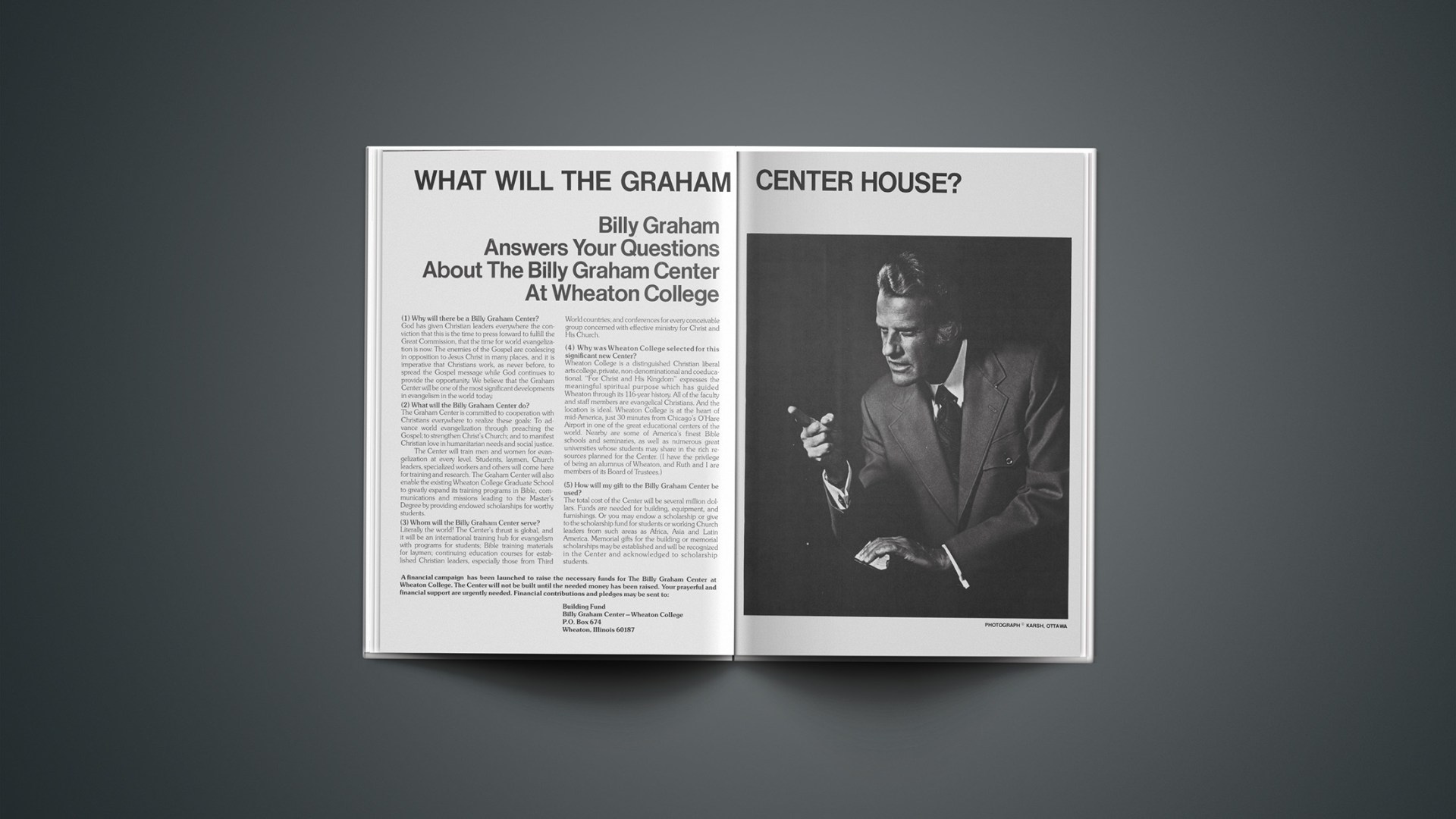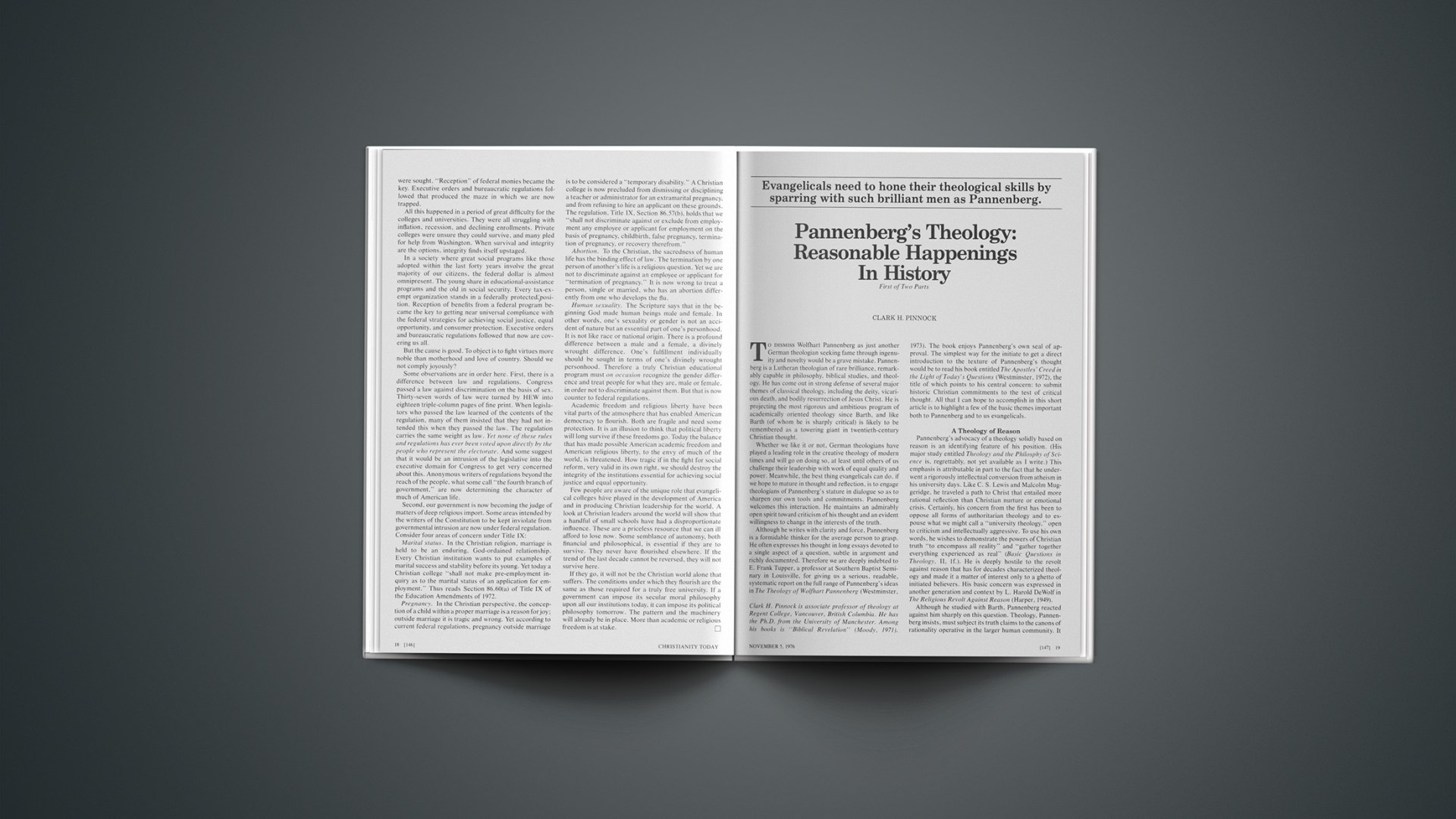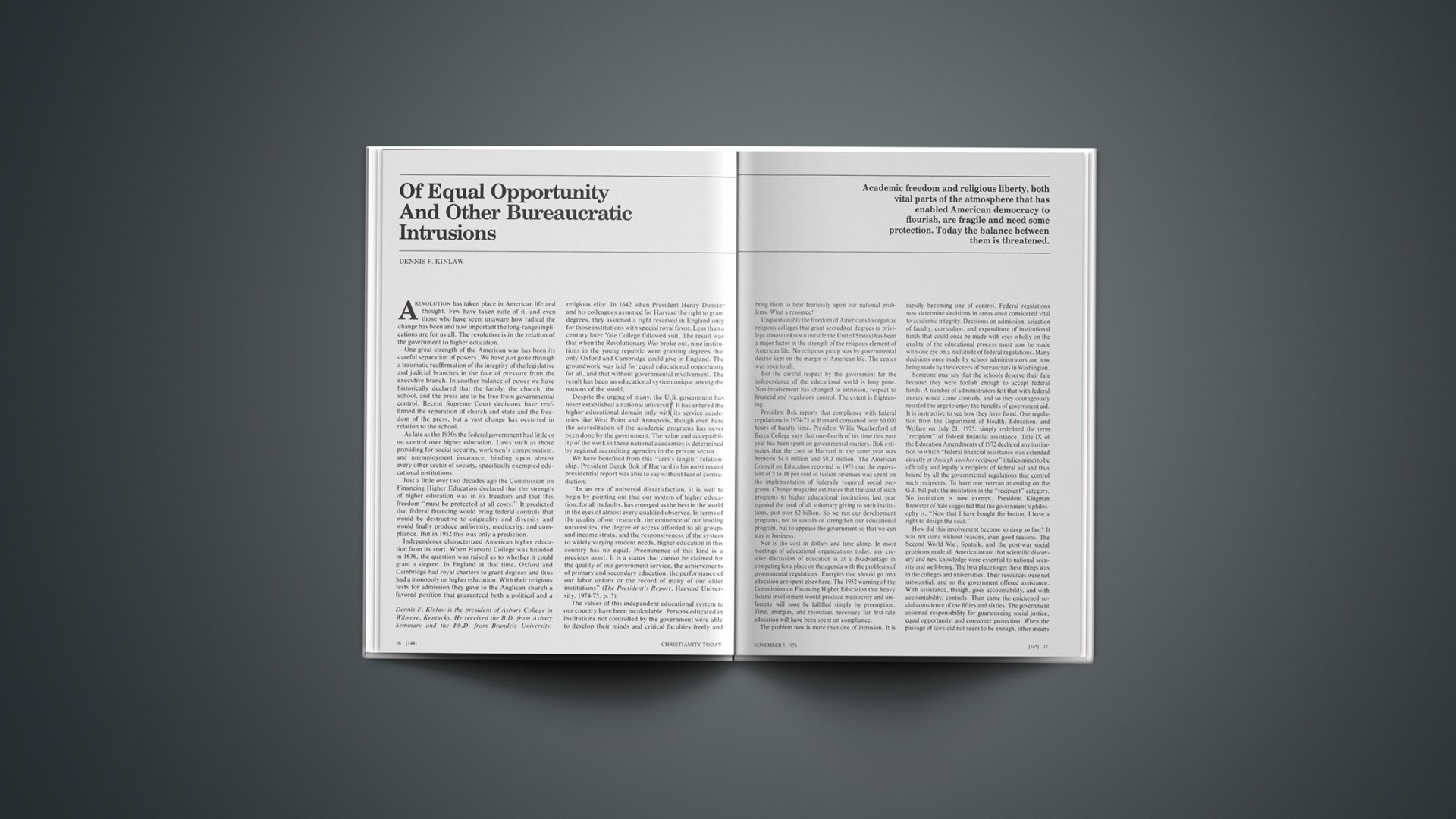Would the National Council of Churches seat Governor George Wallace if the United Methodist Church sent him as one of its delegates to the governing board? Such a question preoccupied the board at its fall meeting in New York City while it was trying to pass a raft of pre-election political announcements.
The United Methodists have not chosen to name the controversial Alabama governor to the NCC board, but his name came up as an example while the policy-making body agonized over the problem of a member who has been accused of World War II crimes in Romania. Archbishop Valerian Trifa of the Orthodox Church in America, the accused, was not present at the meeting last month, but Jewish youths who charge him with “ritual slaughter” of Jews and Christians were there in force. They occupied the platform in the Roosevelt Hotel’s ballroom during a lunch break, and when members returned a shouting match ensued between NCC president William P. Thompson, various members of the board, visitors, and the young Jews. The afternoon business was delayed for more than an hour, but the protesters finally left after they were assured that the matter would be put on the board agenda.
The assignment of considering how inclusive—or exclusive—the NCC should be was given to the board’s credentials committee. Two days later, just before adjournment, it came back with a report that did not gain easy acceptance. The ensuing debate found Thompson taking the unusual step of leaving the chair and speaking from the floor. He defended the report, which stated that member communions alone can determine who represents them on the board. He added that, as a lawyer, he had to assume the Orthodox prelate was innocent until proven guilty. Further, he warned, any attempt to drop Trifa would be an “outright affront” to a member denomination.
“We challenge anything else,” replied board member Arie R. Brouwer of the Reformed Church in America. “Why not this?” The council’s moral authority is at stake, he declared, and he moved to send the whole report back to the committee.
Bringing the issue into sharp focus was clergyman William R. Johnson, Jr., of the Christian Methodist Episcopal Church. He said he “couldn’t sit here” if such arch-segregationists of the last decade as Lester Maddox and George Wallace were sent by member communions. Thompson replied that amendment of the constitution was the way to accomplish any further restriction of board membership (which already must meet quotas for laity as well as clergy, women, youth, and ethnic representation).
Most objectionable to some members of the board was a recommendation at the end of the credentials report. It stated that under the constitution the body had no “authority to judge the alleged activities of Archbishop Valerian nor to challenge the decision of our constituent communion to name him as a member of its delegation.” Instead of sending the whole report back to the committee, the board finally dropped the recommendation section and “received” the committee’s report of its findings. One attempt to suspend the Orthodox prelate pending an investigation was ruled out of order.
Thompson told reporters after the meeting that he had known of the charges against the archbishop for many years but that the allegations had not been discussed in any meeting of the NCC executive committee or board before this session. He suggested that the reason the NCC has not paid much attention to the charges is that Trifa’s denomination considers his record unblemished and that his Romanian archdiocese supports him.
The council president said that neither he nor anyone else in the NCC’s leadership knew of plans for the Jewish protest. He was informed of the platform takeover during the lunch break while he and General Secretary Claire Randall were discussing the afternoon agenda. A young rabbi who was the principal spokesman for the group conferred with Thompson during the recess and, according to the NCC president, agreed to withdraw the protesters if Thompson would permit him to speak to the board for five minutes. The agreement crumbled, however, when the demonstrators remained on the platform after Thompson’s return. He declared an extension of the noon recess, but most members stayed to hear the heated discussion.
Among the exchanges on the floor during the stormy session was one between the rabbi, Avraham Weiss, and black board members who had been in the forefront of demonstrations in the 1960s. The rabbi was asked if he had ever expressed his concern in writing to the NCC. He invoked the name of the late Martin Luther King, Jr., in response, noting that the famous black leader had had to “go beyond the agenda” sometimes to get timely action. Some of the blacks angrily rejected Weiss’s identification of his tactics with those of King. They urged the Jewish leader to work through the NCC channels.
A semblance of order was restored about forty-five minutes after the scheduled start of the afternoon session, and Thompson recognized Sterling Cary, his predecessor, to make a motion about the Trifa matter. During discussion of the Cary motion a former executive of the American Jewish Committee, writer Gerald Strober, sought permission to speak to the board. Thompson refused to recognize him and had his microphone disconnected when Strober continued to speak. Strober, as he was leaving the floor, said to Cary, “Let’s go back to the sixties.…”
The demonstrators finally left after the board voted to refer the matter to its credentials committee. Board members got back to their other business after they had stood for a prayer for the holocaust dead, led by the rabbi.
When the credentials report came back two days later, the current observer from the American Jewish Committee, Rabbi James Rudin, sought recognition. Thompson refused to give him the floor, but the board voted unanimously to allow him to speak. He called the report “morally flawed” and promised a campaign by his organization to “explain” the NCC action.
A formal statement issued later by the American Jewish Committee said Trifa’s continuing presence on the NCC roster “will seriously compromise the moral credibility of the National Council.” Rudin and Rabbi Marc Tannenbaum, the committee’s national interreligious-affairs director, said the least the board could have done would be to suspend the Orthodox prelate.
Many of the board members left New York with the conviction that the problem had not been solved. They were right. In the week following their meeting the Jewish youths appeared at the NCC general secretary’s office to demand more action. After an all-afternoon occupation of the Interchurch Center’s eighth floor, they left with a promise that more consideration would be given to the question at an upcoming meeting of the council’s senior staff.
Trifa, meanwhile, was at home in Michigan preparing his defense for a new set of hearings in federal court. The Justice Department has charged him with lying to immigration authorities about his relation to the anti-Semitic Iron Guard organization during the war. If it is proven that he was a commandant of the organization responsible for atrocities, as charged, he could lose his U. S. citizenship. Orthodox Church authorities contend that he has been cleared of the allegations by various responsible government agencies and that the current drive is a “trial by press” to discredit him.
The Romanian cleric, who became a bishop after coming to America, has attended only one meeting of the NCC board in the last three years. Some veteran board members remember his participation in earlier years, but many of the newer members have never met him.
The New York meeting, one of the liveliest in several years, was also the best attended in about three years. Some 190 (out of 250) board members attended or sent proxies.
With national elections less than a month away, the board concentrated on some of the campaign issues. It addressed a letter to the presidential candidates, calling for a commitment to a “just and sustainable global society.” The document reviews NCC positions on a variety of subjects, including unemployment, nuclear energy, and human rights abroad.
The board also received an “open letter to North American Christians” from a group of Latin Americans who wanted it publicized before the presidential elections. It covered a wide range of social and diplomatic issues. The NCC reply thanked the Latins for raising “the authentic and key issues impacting the relations between our nations and peoples.”
The NCC policy-makers passed one resolution supporting the “forces of liberation” in Southern Africa and warning against “diplomatic overtures of any non-African governments” to resolve the conflicts there. Another resolution asked the United States not to recognize the Transkei (first of the black “homelands” to be granted independence by South Africa) and to press for dismantling of all the Bantustans.
In other actions the board:
• Learned that the Interreligious Foundation for Community Organization (IFCO) had formally become a part of the NCC. IFCO was one of the groups founded in the late sixties to answer black demands for “reparations.”
• Asked for tighter government controls on nuclear materials at home and overseas.
• Addressed a letter of commendation to the “Peace People” of Northern Ireland and Ireland.
• Urged the United States to normalize diplomatic relations with Viet Nam.
• Called for a more active U. S. role in seeking a change in Korean government policies.
• Launched a new campaign against capital punishment.
• Warned against government efforts to define “church” and “religion” for tax purposes.
• Endorsed a California referendum proposition regarding farm labor.
Bingo, Scourge Of Texas Ecumenism
Close to $20 billion will be spent this year in legal gambling, according to researchers (up from the $17.3 billion a University of Michigan survey says was spent in 1974), with an estimated three out of five American adults—90 million people—plunking down money in pursuit of Lady Luck. (Another $5 billion or so will be spent in illegal gambling, the experts say.)
Of this amount, nearly $2 billion will be spent on bingo games. Although it is considered gambling and is therefore illegal in many states, bingo has flourished among Catholic churches, fraternal organizations, fire-house socials, and the like—and the authorities have chosen to look the other way.
Battle lines are being drawn in Texas, where a court recently ruled that bingo is illegal. Police in predominantly Catholic San Antonio say they will enforce the ruling, an announcement hailed by Baptist leaders. Inner-city Catholics, however, warned that the move will deprive their parishes of a chief source of support, and residents of senior citizens’ homes are protesting the elimination of what they call their “only source of recreation.” Several legislators say they may seek special legislation to exempt churches and charities from the law, a move certain to be opposed by the Baptists.
Baptists, who generally have an antigambling stance, and Catholics have clashed on the issue elsewhere in the state. Dallas police, urged on by the Baptists, began a crackdown in Feburary, prompting Catholic bishop Thomas Tschoepe to ask the faithful to comply with the law. (Bingo sponsorship is a felony under the lottery laws and carries a prison sentence of from two to ten years.)
Inducing Growth
The average-size Protestant congregation in America has fewer than 200 members, according to studies discussed at last month’s National Consultation on Evangelism and Church Growth in Kansas City, Missouri. These churches, the studies also show, are for the most part not growing.
More than 450 leaders and key clergy from a broad cross section of denominations and independent groups attended the by-invitation-only consultation to discuss how to get such churches moving—and growing. Many factors were considered in the three days of plenary and small-group sessions: the place of prayer, New Testament guidelines, the role of the Sunday school, statistical analysis, administrative leadership, the nature of ministering to people, family needs, and others.
“We’re interested in disciples, the ones that remain, not just decisions,” commented church-growth expert Vergil Gerber of Evangelical Missions Information Service. “Otherwise, the name of the game becomes numerology.”
“At the same time, we must not slide off on the other side,” cautioned Executive Director Paul Benjamin of the National Church Growth Research Center in Washington, D.C. “Every statistic stands for someone for whom Jesus died.”
Probably the most significant aspect of the consultation was the scheduling of regional workshop sessions in which church-growth conferences were planned for next year throughout the country. The idea is to get as many churches as possible represented at these meetings and to provide plenty of how-to and motivation for congregational involvement in evangelism and nurture that will result in growth. Existing regional resources will be noted in planning, say leaders.
The consultation was sponsored by the American committee of the Lausanne continuation movement (chaired by Southern Baptist pastor Kenneth Chafin), the Evangelization Forum (an informal group that had provided leadership in the Key ’73 nationwide evangelistic thrust, with Victor Nelson of the Billy Graham organization as convener), and other groups.
Invisible Tax
Public utilities in twenty-six states are permitted to make contributions to religious charitable and educational institutions and charge the donations to their ratepayers, according to Americans United for Separation of Church and State. AU brought suit in state courts earlier this year to challenge Pacific Northwest Bell Telephone Company for making substantial contributions to church colleges, with customers involuntarily paying the bill. AU spokesmen say they would have no problem if the donations were taken from stockholders’ profits, but they question whether it is constitutional for “government-regulated monopolies” to make their consumers pay.
“An invisible tax for religion is just as objectionable as a visible one,” says AU researcher Doug Lavine. States showing the highest amounts given to sectarian agencies, he adds, are Oregon, Ohio, New York, Texas, and Illinois.
Camp Crisis
The Texas Supreme Court ruled unanimously last month that an Episcopal Church camp in Hood County is not exempt from property taxes. Bishop A. Donald Davies had filed a suit to establish tax exemption for the camp. A district court ruled that only an open-air chapel and a minister’s residence at the camp were exempt. The remaining 153 acres were declared subject to taxation.
“Certainly, inspiration and a spirit of renewal may be captured by experiences with nature,” the Supreme Court commented, “but those experiences can also qualify as wholesome recreation which falls short of religious worship.”
The effect of the ruling on the tax status of the many other church-affiliated camps in Texas has not been determined.
A Methodist camp at Glen Rose is now in the courts. The Episcopalians sought exemption on grounds the camp was used for worship. The Methodists, however, are claiming their camp is exempt because it is an integral part of Christian education.
Train Up a Child …
Some people assume that academic and intellectual influences spoil the religious commitment of students. Such an assumption is wrong, according to a study of college teachers by researchers at the Catholic University of America in Washington, D.C., and Appalachian State University in North Carolina.
The main sources of religious commitment, or its absence, among college teachers are in early childhood experiences and family conditioning, and later academic training has little effect,” the study concludes.
The findings also show that scholars in the more developed natural sciences are more traditionally religious than are scholars in the humanities and social sciences.
Future in Focus
National conferences on key issues in the practice and theology of world evangelization, an enlarged program of communication to share news of evangelism, and a comprehensive survey of unreached peoples will be the focus of the Lausanne Committee on World Evangelization activities for the next two years. These directions were charted during the recent annual meeting of the LCWE executive committee in Berlin.
The committee took time out from deliberations to issue a statement of support for persecuted Christians in various lands.
General secretary Waldron Scott of the World Evangelical Fellowship was on hand to discuss views and plans of the WEF. The way was left open for joint WEF-LCWE sponsorship of some projects.
From the ten countries and five continents represented by the executive committee came reports of remarkable spiritual activity and growth despite political unrest.
Evangelist Leighton Ford is chairman of the Kenya-based LCWE, and African clergyman Gottfried Osei-Mensah is executive secretary.
Campus Outlook
Christian college campuses are full and overflowing this fall as record numbers of new and returning students boosted many schools past their projected enrollment figures, according to the news service of the twelve-member Christian College Consortium. They are also quiet.
In a survey of campus newspaper editors, the news service found that students at the theologically conservative colleges are expected to be more concerned this academic year with campus matters than with national issues. Getting “moderate interest” will be such issues as the presidential election, the feminist movement, charismatic renewal, world hunger, and recognition of black students’ rights. Most attention, however, will be on grading system revisions, academic calendar changes, and campus regulations, according to the survey.
There have been some changes on campus because of the “Title IX” federal regulations that prohibit sexual discrimination in education. For example, women athletes at George Fox College now enjoy pre-game steaks just like the men—instead of the brown bags they formerly got.
Help For the NAACP
Representatives of the U. S. Catholic Conference, the National Council of Churches, and the Synagogue Council of America have pledged their support of the NAACP in appealing a $1.2 million judgment that threatens its survival. White merchants in Port Gibson, Mississippi, won the judgment against the NAACP under a state law prohibiting conspiracies to injure a business. The case involved a boycott in the 1960s by the NAACP aimed at seeking employment for blacks.
An NAACP spokesman said the organization was already in financial trouble, with liabilities exceeding assets by $200,000.
Said Reform rabbi Alexander M. Schindler: “If blacks can be thrown into bankruptcy for refusing to patronize merchants they regard as hostile to their interests, then Jews can be similarly victimized for withdrawing their patronage from concerns which discriminate against them or who cooperate with the Arab boycott.…”
Food Bank
The Mennonite Central Committee of Canada has set up a government-assisted food bank for world emergency relief. The initial program will run for five years with a maximum reserve at any one time of two million bushels of wheat. Up to $1 million for the first year has been allocated by the Canadian International Development Agency.
The Word in Japan
In commemoration of 100 years of Bible-translation work in Japan, the Japan Bible Society published a new translation of the Gospel of Luke a year ago—the vanguard volume of the Japanese Common Bible Translation. Begun seven years ago, the Bible project involves a committee of forty Protestant, Catholic, and Greek Orthodox scholars. The projected date for finishing the New Testament was 1976, but the work hit a snag, according to charismatic Catholic priest Bernardin Schneider and retired professor Masashi Takahashi, co-chairmen of the editorial committee. The new target date is the end of 1977, with the Old Testament to follow four years later and the Apocrypha sometime after that. Meanwhile the Gospel of Luke is open game and is receiving both compliments and criticism.
The new Common Bible is intended to make the Bible understandable to a non-Christian with a non-church vocabulary, to adhere to the original languages, and to have a non-foreign-sounding, true Japanese style. But in a long review, Tokyo’s popular Asahi newspaper said that the new Bible was too radical in its differences from other Bibles available in Japanese.
The major issue involves the transliteration of names and places into Japanese. For example, it is impossible to spell “David” in Japanese, so the earlier Bibles render him “Dabide” (da-bee-day); the new one changes it to “Dabido.” The committee compromised after a long battle over the name Jesus: Protestant “Iesu” plus Catholic “Iezusu” comes out “lesusu” in the Common Bible. Whether for sake of compromise or for a sound that is closer to the original Hebrew or Geeree shiago (Greek), the task has been tough: more than 500 Greek proper names and 2,600 Hebrew names in the Old Testament were tagged for study.
A second issue concerns the alleged use of “discriminatory” words. The mass media in Japan are being bombarded by a Communist-backed faction accusing the Bible translators of discrimination against the blind and other socially handicapped. The organization has picked out eleven words that they say are taboo and should be avoided in the Bible. Because mekura for “blind” is also used in reference to a blind animal, for instance, the word should be changed to a more polite mojin or me ga mienai hito to specify “a person whose eyes cannot see.” The same principle applies to “lame,” “deaf,” or “dumb.” “Leper” should be changed to “one with Hansen’s disease.”
Highly conscious of social status, the Japanese adjust their language to three distinct levels of social rank, depending on the one being spoken to. Hence the verb forms used when Jesus is speaking to his disciples are questioned. As their teacher, wasn’t he above them? Yet he washed their feet.
The new translation claims to be “more polite than the language of the Living Bible” and “more readable than the Kogotai” (a 1955 version similar to the King James that still has sales of 1.5 million a year).
For the most part, pastors do not seem to be using the new gospel of Rukas (Luke), and when asked about the “new Bible” they often reply, “You mean the Shinkaiyaku Seisho?” Published in 1970, by Japan Bible Publishers, that six-year-old colloquial version is still new to some. It has sold over a million copies and presently sells about 190,000 a year, according to a spokesman.
President Kenneth McVety of Word of Life Press in Tokyo reports that the Living Bible New Testament paraphrase, released in Japanese in October, 1975, is averaging 8,000 sales a month, with 180,000 in print as of September. The Old Testament is expected to be completed next year.
Although many Christians voice doubts about the need for another Bible translation, the Bible Society says it is not only possible but necessary to make the common version. The latest Catholic edition is a 1965 publication, though in the last four years large numbers of Catholics in Japan have been using the two latest Protestant versions (Kogotai and Shinkaiyaku Seisho).
The oldest Bible in Japan, the 1888-vintage Bungotai, is revered by the Baptist Bible Fellowship and other fundamentalist groups (some are working on their own private translations). The Bungotai was Japan’s first Bible, but in schools today the language it uses is considered classical and obsolete.
Early disciples of the mukyokai no-church church movement in Japan also translated portions of the Scriptures, but the movement in general uses the two post-war Protestant versions.
Also, there are a Mormon “Bible” and a Jehovah’s Witness “Bible” in Japanese.
In a 1975 survey that included reading matter of all kinds, 56.3 per cent of a cross section of Tokyo residents indicated they had read the Bible or parts of it, with 6 per cent saying they read it regularly. Another 8.5 per cent said they want to read it, while 35.2 per cent indicated no interest in reading it.
Judging by continuity of sales, the Bible is a best-seller in Japan. However, although bookstores are almost as plentiful as cold drinks, the average man on the street would have a hard time buying any version of the Scriptures except in a few Christian bookstores and in three or four major bookstores in the large cities. Book dealers avoid it because they favor faster-moving material on their crowded shelves—and because it might subject them to criticism by Shintoists and Buddhists.
NELL L. KENNEDY
The Pentecostal Tide Is Coming In
As English Labor government leaders struggled over the crises of the falling pound, Pentecostal leaders from more than eighty nations gathered in London in September for the eleventh triennial meeting of the World Pentecostal Conference. The 12,000 delegates represented more than 350 national Pentecostal denominations from around the world. Morning sessions were held in the Westminster Central Hall, the “cathedral” church for English Methodism, and the evening rallies were conducted in the 8,000-seat Royal Albert Hall. On the final night of the conference, both halls overflowed for the closing communion service.
The purposes of the conference, according to Chairman Thomas F. Zimmerman, top leader of the U. S. Assemblies of God, was to “recognize what God is doing in what may be the broadest based outpouring of the Spirit the Church has ever experienced,” and to “assess the unfinished task as God gives us to see it.” In his address, Zimmerman proclaimed that there are from 35 million to 50 million Pentecostals in the world and that “the end is not near.” The “Pentecostal tide is coming in,” he declared. He left little doubt that classical Pentecostals consider themselves to be first of all evangelicals. He declared that the Holy Spirit gave the Church “the inspired and inerrant Word of God,” which is “superior to any tongue or prophetic utterance.” He noted in conclusion that the “triumph of the Holy Spirit is worldwide evangelism.”
Although all twelve conference speeches dealt with some facet of the person and work of the Holy Spirit, the challenge of evangelism was a prominent note throughout the meetings. Featured speakers included pastors of some of the largest Pentecostal congregations in the world. Yongii Cho reported that his Full Gospel Assembly of God congregation in Seoul, Korea, numbers 40,000 members, an increase of more than 8,000 in the past year. Javier Vasquez, pastor of the Jotabeche Pentecostal Methodist Congregation (affiliated with the Pentecostal Holiness Church) in Santiago, Chile, reported 80,000 members. Also featured was K. E. Heinerborg, pastor of Stockholm’s 7,000-member Filadelphia Pentecostal Assembly. Practically all the representatives reported significant growth in their lands since the last conference three years ago.
In contrast to the neo-Pentecostal practice in large meetings of allowing charismatic gifts to be exercised only by a trusted “word gifts unit,” tongues and prophecies came forth from all over the Royal Albert Hall. In one instance a “message” was given in glossolalia, interpreted in German, and then interpreted in English.
A striking feature of the conference was the appearance of twenty delegates from Eastern European Communist countries. These included six pastors from the Soviet Union, representing the nation’s 600,000 Pentecostal believers. Others came from Bulgaria, East Germany, Hungary, Poland, Yugoslavia, and Romania. In welcoming the Iron Curtain delegates, Zimmerman declared that “the World Pentecostal Conference is not political.… We can enjoy fellowship of the brethren from any part of the world.… Ideological differences do not divide us.” Despite these statements, some delegates who have traveled in these nations contended privately that these men represented not the “true Pentecostal believers” but rather government-recognized churches that had compromised their testimony for government approval. The overwhelming spirit of the conference, however, was to give a warm hand of fellowship to the official delegates as true brothers in Christ.
The existence of the rapidly growing charismatic movements in the traditional churches was hardly noted during the conference. Instead of a triumphalism concerning the incursion of Pentecostalism into other traditions, a non-recognition policy seemed to exist. (Generally, classical Pentecostals feel that Christians who speak in tongues ought to join a Pentecostal denomination.) Yet in small ways the conference opened some windows toward the charismatics. David du Plessis, known as “Mr. Pentecost” to the charismatics but as a maverick to the Pentecostal power structure, was publicly recognized and applauded. Michael Harper of the Anglican Fountain Trust and Dan Malachuk of Logos International were also publicly received. In addition, the somewhat controversial Society for Pentecostal Studies, which was formed at the 1970 World Pentecostal Conference in Dallas, Texas, was recognized as an official research agency for the world Pentecostal movement.
In conference business, an expanded advisory committee of twenty-four persons representing the various continents of the world was approved, and Canada was chosen as the site of the 1979 conference.
VINSON SYNAN
East Germany: Taking a Stand
Four weeks after a clergyman set himself on fire outside his church in Zeitz, East Germany, to protest the oppression of Christian young people by the Communist government (see September 10 issue, page 81), pastors in 4,300 Evangelical (Lutheran) churches throughout the land read a sensitive sermon from their pulpits calling for increased religious freedom. The sermon was a pastoral letter drafted by the leadership conference of the Evangelical Church. The five regional newspapers of the church, with a combined circulation of 150,000, were forbidden by the government to print the statement.
The text of the sermon was “One member suffers, all the members suffer.” It said that pastor Oskar Bruesewitz’s self-immolation aroused deep concern over “the tensions that exist in our society, as well as the severe problems that many of us face.” Affirming that the pastor “wanted to be a witness of our Lord Jesus Christ” in what he did (government authorities claimed he was mentally ill), the statement said his action gave rise to serious questions, including “whether there is really sufficient freedom of belief and freedom of conscience [in East Germany], particularly for young people.”
Suppression of problems serves neither society nor the church, the sermon declared. “We must therefore take a stand to see to it that in our society respect for the convictions of others truly determines the coexistence and cooperation of people of diverse views.”
The sermon said it is “particularly urgent” that “an atmosphere of confidence be created in our socialist educational system, so that children and young people may live as Christians without being subjected to humiliations.…”
Christian children are under great pressure in schools not to practice their faith, according to church sources, and many Christian young people who do are barred from higher education.



